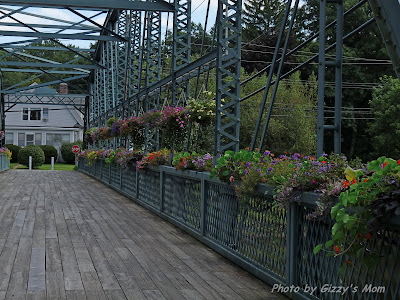Boston's New Bridge of Flowers
By Carol Stocker
Almost a century before New York's celebrated High Line was converted from an abandoned elevated railroad spur into an aerial park, Shelburne Falls near Greenfield created its famous Bridge of Flowers from an abandoned railroad bridge over the Deerfield River in a true pioneering act of readapting the refuse of the industrial age.
Next summer Boston may have its own "bridge of flowers" over the Fort Point Channel on the historic 1908 metal truss "swing" bridge.
The Boston Committee of the Garden Club of America has contributed $60,000 to benefit horticultural beautification projects for two of the busiest pedestrian crossroads around the Rose Kennedy Greenway. At the Nov. 16 annual meeting, Chair Michele Hanss gave The Boston Harbor Association a $50,000 grant for installation of a horticultural display along the historic Old Northern Avenue Bridge linking the Rose Kennedy Greenway with the developing Seaport District.
The "Harbor-Link Gardens" proposal will transform the bridge, once considered an eyesore by many, with planters of labeled hardy seaside perennials and shrubs and with blue colored paving.
The Boston Committee's Blossom Fund also presented $10,000 for the Christopher Columbus Park Circle Project to JoAnne M. Hayes-Rines, president of Friends of Christopher Columbus Park. This seed money will underwrite redesign of the misconceived pedestrian circle at that waterfront park.
Pedestrian use of both areas has greatly increased since completion of The Big Dig.
The office of Mayor Thomas M. Menino's issued his statement of support: "Beautifying this bridge will attract more visitors to the popular Harborwalk and act as a fitting gateway to our rapidly growing Innovation District. Improving the Northern Avenue Bridge will also create a visual link to the Rose Kennedy Greenway, and I commend the partnership of public, private and non-profit sectors to help get the job done."
At its annual meeting at The Country Club in Brookline, Hanss also presented Vivien Li and landscape architect David J. Warner, of Warner Larson Landscape Architects, with an Asian spruce, the first plant for the project, which is scheduled for spring completion. Li is president of The Boston Harbor Association, which has succeeded in creating the 40 mile Harborwalk which surrounds and is connected by the bridge. "This generous support will help to set a standard for future plantings and sustainable design along the waterfront," she said, adding that local businesses will help with long term maintenance. Nearby luxury hotel developer Eric Sachsse voiced support and called the modest initiative "exceptionally impactful." Landscape architect Warner Larson will provide pro bono services for the design and oversight of the installation.
Funding from the Boston Committee of the Garden Club of America is raised from a membership of 1100 women from 14 garden clubs in Greater Boston and southern New Hampshire. Said Hanss, "The mission of our consortium is to support horticultural initiatives in Boston that can have an impact on a greater number of people than similar projects each of our member clubs undertaking in our individual communities. Making horticulture and open space a priority in Boston will have a ripple effect throughout the region."
The Boston Committee meeting's speaker was Don Rakow, director of the Cornell Plantations, which encompasses 150 acre arboretum and over 4300 acres of natural areas at Cornell University. His research focuses on the history and management of public gardens. He said urban parks began a revival in the1990's with the return of affluent populations to the city's center. (He mentioned that the Boston Common, created in 1634, was the nation's first urban park.)
Major trends in public gardens that Rakow identified including children's gardens, and efforts to broaden use with multi-lingual signage, wheelchair accessible entries and distribution of free passes at churches and WIC sites.
Public gardens are also wrestling with climate change, Rakow said. Staff at the Arnold Arboretum have documented that many plants are blooming 10-14 days earlier in the spring than those collected in the past as herbarium specimens for Harvard.
And if its still needed after Hurricane Sandy, here's another climactic change caveat: on August 28, 2011, rain runoff from Hurricane Irene (at that point a tropical storm) flooded the Deerfield River and engulfed the Bridge of Flowers in Shelburne Falls.





